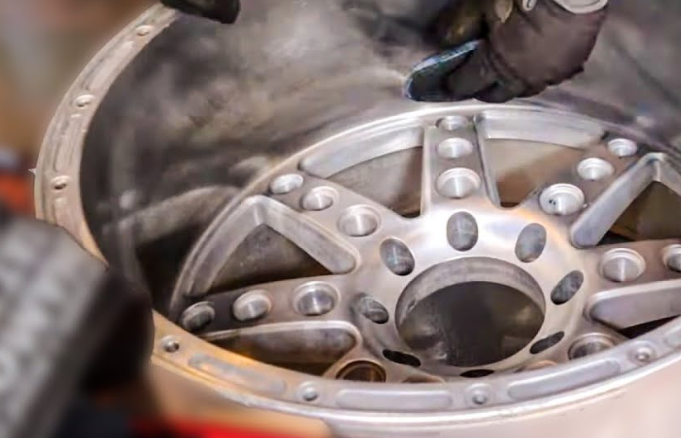Polishing can make the cast aluminum parts look new and even shiny, this article is going to introduce how to polish cast aluminum to a mirror finish and keep it.

How to Polish Cast Aluminum?
Can die cast aluminum be polished? Yes, die cast aluminum can be polished to achieve a smooth and shiny finish. Here are the steps to polish cast aluminum:
1. Clean the surface: The first step is to clean the die cast aluminum surface thoroughly with soap and water. Make sure to remove any dirt, grime, or debris from the surface.
2. Remove any roughness: If the surface has any rough spots, buff them out using a coarse-grit sandpaper.
3. Use finer-grit sandpaper: Move to finer-grit sandpaper to make the surface even smoother. Depending on the condition of the surface, you may need to use progressively finer grits and even polishing compounds.
4. Apply polishing compound: Apply a polishing compound to the surface using a polishing cloth or buffer. There are a variety of polishing compounds available, so choose one that is compatible with aluminum and the specific finish you’re trying to achieve.
5. Polish the surface: Use a polishing cloth or buffer to polish the surface with the polishing compound until it reaches the desired finish. Be sure to follow the instructions of the polishing compound to obtain the best possible results.
6. Apply a protective coating: After polishing, it’s best to apply a protective coating to prevent oxidation and maintain the polished finish. Options include a clear coat or wax.
Tips for polishing cast aluminum to mirror finish
Polishing cast aluminum to a mirror finish can be challenging, so here are a few tips that can help you achieve the best possible results:
1. Use a multi-step approach: To achieve a mirror finish, use a multi-step approach that involves progressively finer grit sandpaper, metal polish, and polishing compounds. Start with coarse-grit sandpaper, then move on to finer grits, metal polish, and polishing compounds.
2. Wet sanding: Wet sanding with water can help remove abrasive particles and produce a smoother surface.
3. Apply even pressure: When using a buffing wheel or polishing cloth, apply even pressure to the surface. Uneven pressure can create swirl marks and prevent you from achieving a smooth, mirror finish.
4. Avoid overheating: Overheating aluminum can cause it to warp or develop cracks. Use a light touch when sanding or buffing, and take breaks to allow the surface to cool down.
5. Clean the surface frequently: Cleaning the surface of the aluminum between each step can help ensure that you are removing all blemishes and scratches from the previous step.
6. Check your progress: After each step, check your progress by using a clean, dry cloth to inspect the surface of the aluminum. This can help you identify any remaining scratches or blemishes that need to be removed in the next step.
7. Use a dedicated workspace: Using a dedicated workspace will not only help you keep your equipment organized, but it will also prevent any contaminants from getting on your polished aluminum surface.
Should you wax aluminum after polishing?
It’s generally a good idea to apply wax or a clear coat after polishing aluminum to protect the surface and maintain its shine. This is because aluminum is prone to oxidation, which can cause the surface to become dull and lose its shine over time. A protective coating can help prevent oxidation and keep the aluminum looking shiny for longer. There are different types of protective coatings that can be used on aluminum after polishing, including clear coats and waxes. Clear coats provide a durable, long-lasting protective layer that resists scratches and other types of damage. Waxes, on the other hand, offer a more natural finish and can be easier to apply. Both types of coatings can help protect aluminum from environmental factors, such as moisture, UV rays, and pollutants.
To apply a protective coating to your polished aluminum surface, first, clean the surface thoroughly with a bar of mild soap and water or a specialized aluminum cleaner. Dry the surface completely before applying the coating. Follow the manufacturer’s instructions for applying the chosen coating, and use a soft cloth or applicator to ensure even coverage. Allow the coating to dry completely before handling the aluminum surface. While not strictly necessary, applying wax or a clear coat after polishing aluminum can help protect the surface and maintain its shine. Choose a coating that is compatible with aluminum and follow the manufacturer’s instructions for best results.
How Do You Keep Aluminum Shiny After Polishing?
After polishing aluminum to a mirror finish, it’s important to take steps to protect the surface and keep it shiny. Here are some tips to help you maintain the shine of your polished aluminum:
1. Applying a clear coat or wax can help protect the polished aluminum surface from oxidation and maintain its shine. Follow the manufacturer’s instructions for the best results.
2. Regularly using a high-quality metal polish can help remove surface contaminants and maintain the shine of the aluminum. Apply the metal polish with a soft cloth or polishing wheel and buff the surface evenly.
3. Regular cleaning can help prevent dirt, grime, and other contaminants from building up on the polished surface. Use a mild soap and water, or a specialized aluminum cleaner, to clean the surface and avoid using abrasive cleansers or scrub brushes that can scratch the surface.
4. Exposure to harsh chemicals, such as acidic or alkaline cleaning agents, can damage the polished surface of aluminum. Avoid using these chemicals on your polished aluminum surface.
5. Store polished aluminum items in a clean and dry location that is protected from the elements. Exposure to moisture and sunlight can cause the surface to corrode and lose its shine.
6. Handle polished aluminum items with care to avoid scratching the surface. Avoid stacking or placing heavy objects on top of polished aluminum surfaces.

